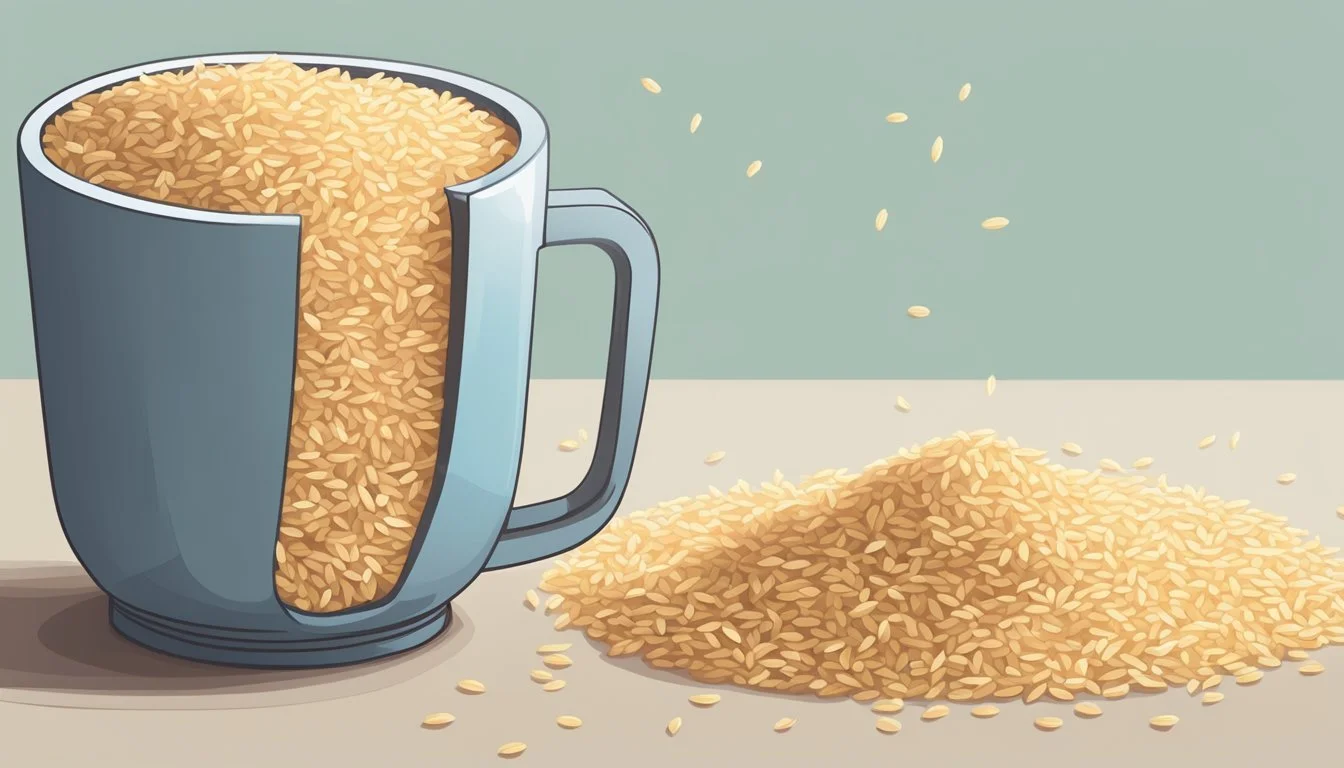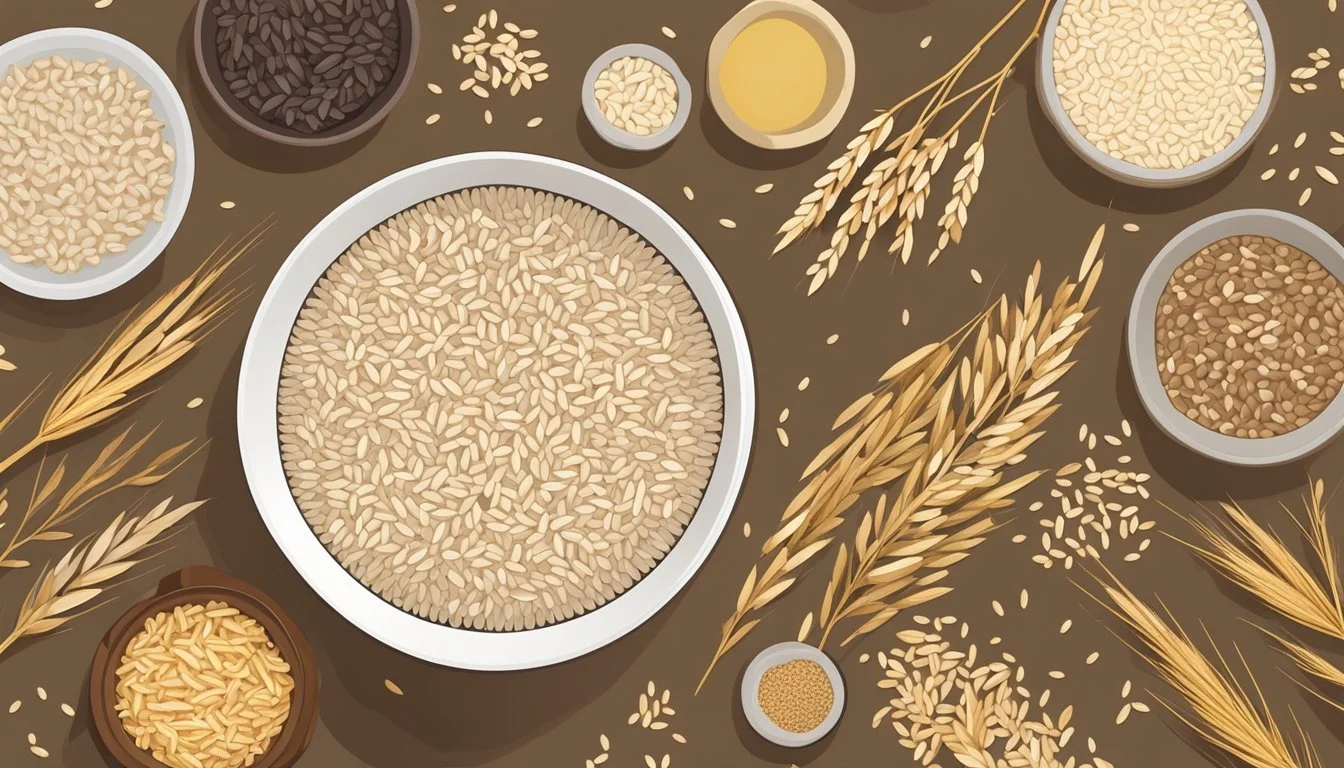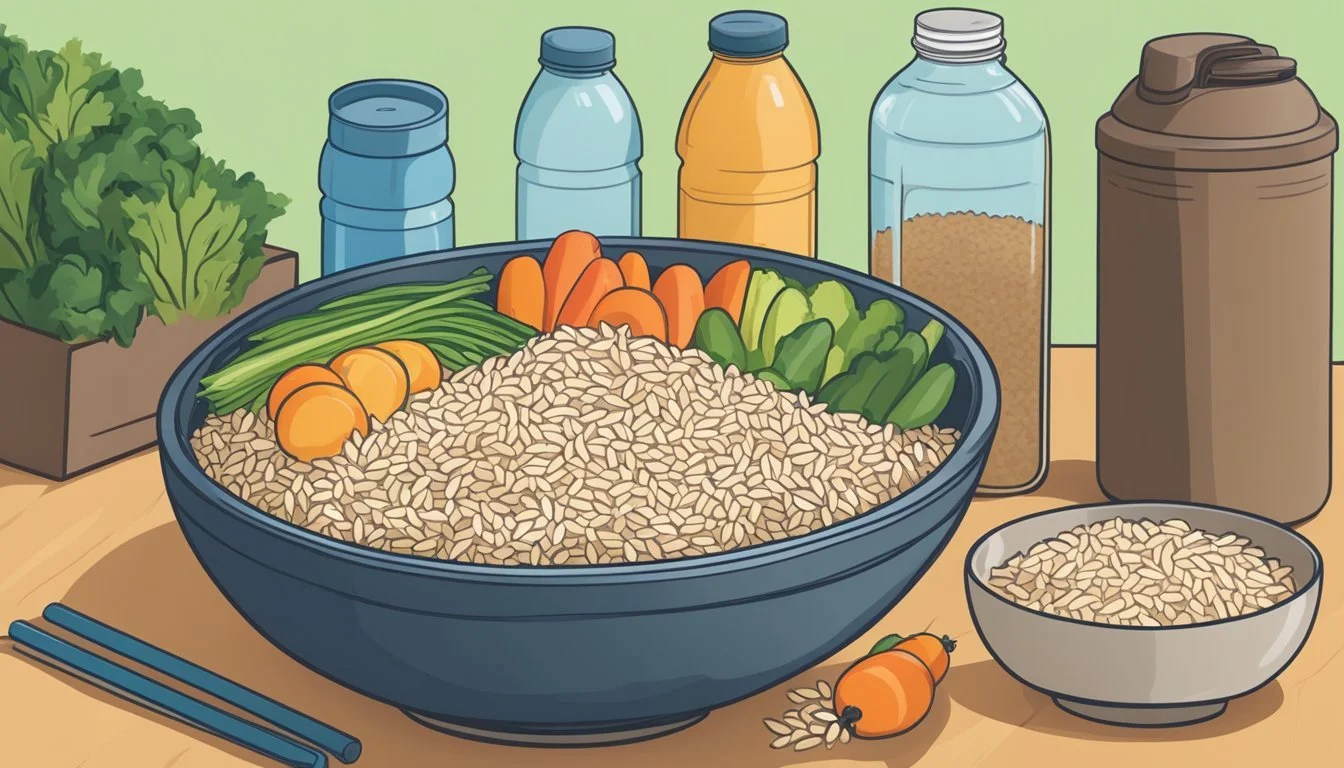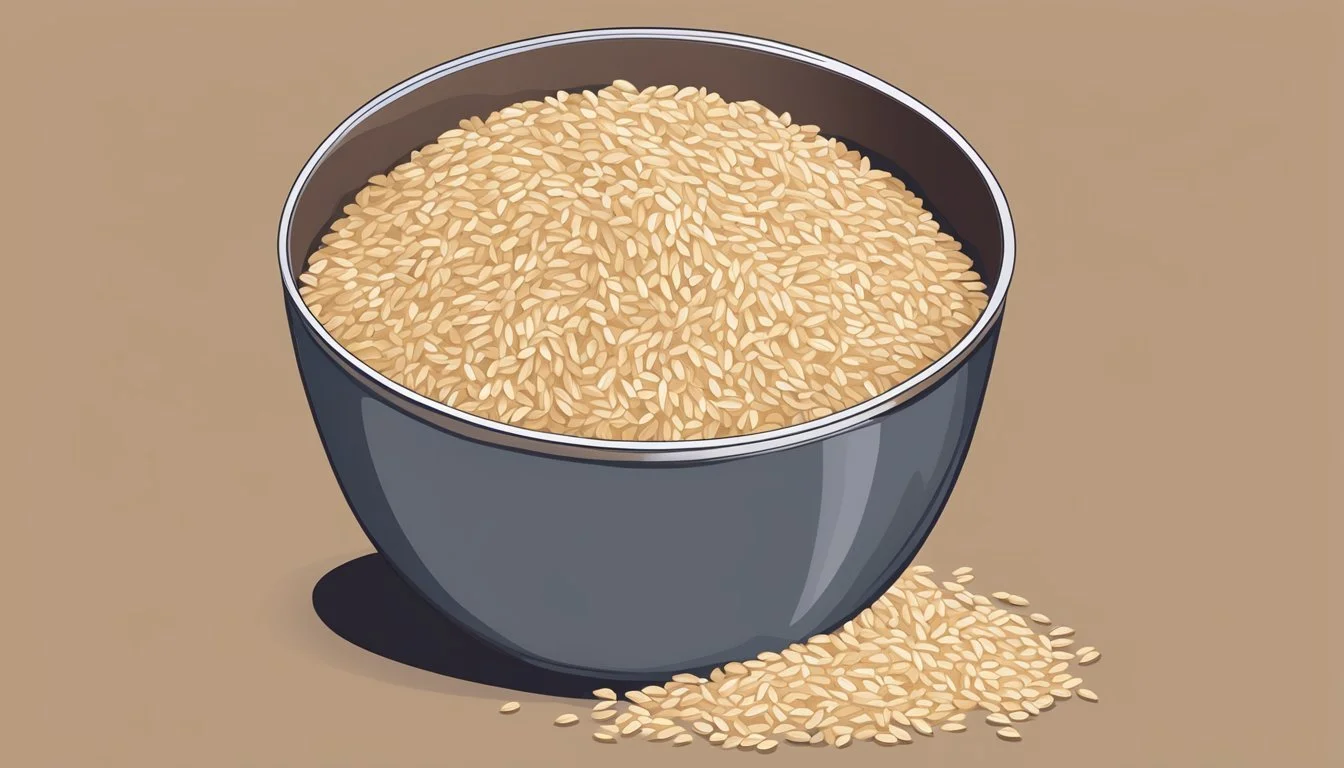How Much Brown Rice Per Day Is Too Much?
Setting Healthy Limits
Brown rice is a whole grain that has become a staple in many health-conscious diets due to its nutritional benefits. Being a rich source of fiber, vitamins, and minerals such as vitamin B, magnesium, and zinc, it forms an essential part of a balanced diet. However, the amount of brown rice one should consume daily is not one-size-fits-all; it primarily depends on individual dietary needs and overall calorie intake.
For a person following a standard 2,000-calorie diet, incorporating about 6 ounces of grains per day, with at least half being whole grains like brown rice, is generally recommended. This translates to roughly a couple of servings of brown rice—each serving being ½ cup cooked. Meanwhile, for those on limited-calorie diets or who have higher energy expenditures due to intense physical activity, the recommended quantity may differ. Nutritionists advise that grains should not displace other important nutrients and foods required for a well-rounded diet.
While incorporating brown rice into meals is beneficial, it's also necessary to consider the potential for anti-nutrients such as phytic acid, which can affect the absorption of certain minerals. Moderation is key, even with nutritious foods such as brown rice, to minimize any adverse effects and to ensure that the diet remains varied and balanced.
Nutritional Comparison of Brown Rice to Other Grains
When considering the food value of different grains, brown rice stands out for its whole grain benefits, offering a rich profile in fiber, protein, and essential nutrients compared to refined grains like white rice.
Brown Rice vs. White Rice
Brown rice is a whole grain that retains its bran and germ, which are removed in white rice during the milling process. Brown rice offers more fiber and protein compared to white rice. Additionally, it is a significant source of magnesium, a mineral important for bone health and metabolic functions. In contrast, white rice has fewer nutrients as the milling process strips away the bran and germ, resulting in a grain primarily composed of carbohydrates with fortified, but not naturally-occurring, nutrients.
Brown Rice and Whole Grains
Compared to other whole grains, brown rice is similar in its high fiber content, which is paramount for digestive health. It also contributes a moderate amount of protein compared to other grains. Grains like quinoa and barley might offer more protein per serving, but brown rice is a gluten-free option that is inclusive for those with gluten sensitivities. Whole grains generally share a common benefit: the presence of bran and germ, which are rich in nutrients and health-protective compounds.
Comparison to Other Common Grains
Looking at the nutritional makeup, here's how brown rice measures up against some common grains per cooked cup:
Brown Rice: Approximately 45g of carbs, 3.5g of fiber, 5g of protein, and a good amount of magnesium.
Quinoa: Approximately 40g of carbs, 5g of fiber, 8g of protein, along with iron and magnesium.
Barley: Roughly 44g of carbs, 6g of fiber, and 4g of protein.
Wild Rice: Typically contains 35g of carbs, 3g of fiber, and 7g of protein.
Each grain brings its own set of nutritional advantages, but brown rice uniquely balances fiber and protein while being a staple food for those looking for whole grain benefits without gluten.
Health Benefits of Brown Rice
Brown rice is acclaimed for its nutritional profile, offering a rich supply of fiber, essential vitamins, and minerals. It stands out as a staple food that contributes to various aspects of health, including blood sugar management and chronic disease prevention.
Rich Source of Fiber and Nutrients
Brown rice offers a variety of nutrients vital for maintaining a healthy body. It is a dense source of fiber which aids in digestion and provides a feeling of fullness. Each serving contains protein, magnesium, and antioxidants that support muscle repair, energy production, and cellular health respectively. Brown rice also supplies important vitamins such as B-vitamins, which play a key role in metabolism.
Fiber: Helps digestion
Protein: Aids muscle repair
Magnesium: Fuels energy production
Minor nutrients: Iron, Zinc
Management of Blood Sugar and Diabetes
Replacing white rice with brown rice can impact blood sugar levels favorably. Brown rice has a lower glycemic index, which helps in the slow release of glucose into the bloodstream, thereby aiding in the management of diabetes. Consistent evidence points to whole grains like brown rice reducing the risk of developing type 2 diabetes.
Contribution to Heart Health
Consuming whole grains such as brown rice has been associated with a reduction in cholesterol levels, making it beneficial for heart health. The fiber in brown rice helps in lowering bad cholesterol and maintaining healthy arteries, making it a heart-healthy choice. Essential minerals like magnesium also contribute to heart function and health.
Cancer Prevention
Regular intake of whole grains, including brown rice, may be linked to a lowered cancer risk. The fiber content in brown rice is thought to have a protective effect, particularly against colorectal cancer. Antioxidants and other beneficial compounds in brown rice also play a role in cancer prevention, by minimizing oxidative damage to cells.
Potential Risks and Considerations
When incorporating brown rice into a diet, it’s important to balance its health benefits with potential risks. These risks mainly concern arsenic content, digestive health, and how brown rice may affect the absorption of other nutrients.
Arsenic Content Concerns
Brown rice is known to contain higher levels of inorganic arsenic compared to white rice; this is largely due to the outer layer of bran that remains on brown rice. Arsenic is a natural element that can pose health risks when ingested in large amounts over time. Studies suggest that the average inorganic arsenic concentrations are about 154 parts per billion (ppb) in brown rice. To minimize this risk:
Limit intake of brown rice to a few servings per week.
Rinse and cook brown rice using a higher water-to-rice ratio, which may reduce arsenic content.
Digestive Issues and Allergies
Although brown rice is gluten-free and generally more digestible than some other grains, it can still cause digestive discomfort in some individuals. This is partly because it is a rich source of dietary fiber, which can be hard on the digestive system if not introduced gradually. Additionally, some individuals might have specific allergies or sensitivities to brown rice. Symptoms might include:
Bloating
Gas
Stomach cramps
Interactions with Nutrient Absorption
Brown rice contains phytic acid, an anti-nutrient that interferes with the absorption of minerals such as iron and zinc. Regular consumption of high-phytic acid foods can potentially lead to mineral deficiencies. However, this is rarely an issue if one consumes a varied diet rich in whole grains. Strategies to improve nutrient absorption include:
Soaking or fermenting grains before cooking.
Combining brown rice with vitamin C-rich foods to enhance iron absorption.
Recommended Daily Intake and Overconsumption
Determining the optimal intake of brown rice involves understanding nutritional needs and recognizing symptoms of overconsumption. Brown rice is a nutrient-dense food that contributes to a balanced diet but intake should align with individual dietary requirements.
USDA Dietary Guidelines
According to USDA Dietary Guidelines, adults should aim for at least half of their grain consumption to be whole grains, like brown rice. For a standard 2,000-calorie diet, this translates to about 6 ounces of grains daily, with at least 3 ounces as whole grains. One ounce of grains is equivalent to one-half cup of cooked rice. The guidelines stress the importance of not exceeding daily calorie needs to maintain weight and health.
Nutrient profile for a typical serving of cooked brown rice (1 cup):
Calories: Approximately 220
Carbohydrates: 45 grams
Fiber: 3-4 grams
Fat: 1.5-2 grams
Sugar: 0 grams
This whole grain is an excellent source of nutrients including selenium, folate, B vitamins, and is beneficial for blood sugar control due to its lower glycemic index.
Signs of Excessive Intake
While brown rice is healthy, too much of it can lead to overconsumption of calories and carbohydrates, potentially resulting in weight gain and imbalanced blood sugar levels. Signs that one might be eating too much brown rice include:
Weight gain beyond dietary goals
Elevated blood sugar levels
Abdominal discomfort or bloating due to excessive fiber intake
Individuals concerned about their intake should consult with a dietitian to tailor their consumption to their nutritional needs, health status, and activity level.
Incorporating Brown Rice into Your Diet
Brown rice is a versatile whole grain that can be a nutritious addition to a variety of meals, offering dietary fiber, vitamins, and minerals. Its inclusion in the diet should complement a rich array of other food groups to maintain a balanced diet.
Recipes and Cooking Tips
A plethora of recipes exist that can make the addition of brown rice to one's diet both delicious and nutritious. For a wholesome meal, one might opt for dishes like:
Chicken and Brown Rice Soup: A heart-healthy soup that combines lean protein with high-fiber brown rice.
Brown Rice Salad: Mixed with an array of vegetables, dressed with olive oil or citrus, for a refreshing and fibrous dish.
Fish and Brown Rice Pilaf: Utilizes the light flavors of fish and combines them with the nuttiness of brown rice.
Tofu Stir-fry with Brown Rice: Incorporates tofu as a plant-based protein and a variety of vegetables for a balanced meal.
Cooking brown rice requires more water than white rice. Typically, the ratio is about 2 1/2 cups of water for every 1 cup of brown rice. It also takes longer to cook, about 30-45 minutes.
Creating a Balanced Diet with Brown Rice
Brown rice should not stand alone but rather be part of a balanced diet including:
Fruits and Vegetables: They add vitamins and antioxidants to meals.
Lean Proteins: Such as chicken, fish, or tofu, to aid with muscle repair and growth.
Dairy or Dairy Alternatives: These provide calcium and vitamin D. A glass of milk or a serving of yogurt can complement a brown rice dish well.
Other Whole Grains: To vary fiber sources and nutrients.
Hydration is crucial. Including fluids like water or healthy soups helps with digestion of high-fiber foods like brown rice.
A well-balanced diet aids in maintaining a healthy weight and may be heart-healthy. Brown rice, as a side dish or integrated within recipes, can help achieve these dietary goals when consumed in appropriate daily amounts.
Brown Rice in Different Cultures
Brown rice, revered for its nutritional value and versatility, holds significant importance in various cultural cuisines worldwide. It is especially prominent in Asian cooking and has inspired a range of culinary dishes globally.
Brown Rice in Asian Cuisine
In Asia, brown rice is not simply a food item; it's a staple ingrained in the daily life and traditions of its people. Especially in India, where brown rice is often used as a healthier alternative to white rice, it's incorporated into everyday meals and special dishes alike. One can find a variety of preparations such as biryanis, pilafs, and even dosas, which are typically made with this hearty cereal grain. The integral role of brown rice in Asian cuisine is a reflection of the region's long-standing emphasis on balance and wholesomeness in their diet.
Global Varieties and Culinary Uses
Globally, brown rice is lauded for its adaptability in an array of recipes. From the warm, nutty aroma of a California brown rice salad to the heartiness of a South American brown rice and black beans dish, the use of brown rice spans continents. Its versatility extends into its ability to be ground into flour, popped like corn, or even brewed into sake in Japan. Here is how brown rice is used in different regions:
Asia: Steamed or boiled as a side, integral to sushi, or in aromatic mixed rice dishes.
India: Key in biryanis, idlis, and various rice-based snacks.
California: Often found in health-conscious recipes, such as rice bowls with locally-sourced vegetables.
This versatile grain adapts to flavors and cooking methods across cultures, making it a truly global ingredient.
Environment and Sustainability Factors
In discussing brown rice consumption, it is important to consider the environmental implications of rice cultivation as well as the food's potential as a sustainable choice, focusing on the impact on soil health and overall sustainability.
Impact of Rice Cultivation on Soil
Rice cultivation has a significant influence on soil health. Paddy fields, traditionally used for growing rice, lead to waterlogged soil conditions that can reduce soil aeration and alter the microbe community. These conditions are conducive to the production of methane (CH4), a potent greenhouse gas. The intensive cultivation of rice also tends to deplete soil nutrients, necessitating the use of fertilizers that may contribute to soil and water pollution through runoff containing excess chemicals.
Brown Rice as a Sustainable Food Choice
Brown rice, with its outer layers intact, maintains more of its nutritional value compared to white rice, and these layers require less processing. This results in lower energy consumption and a reduced environmental footprint. Additionally, the water requirements to produce brown rice are generally similar to those for white rice, but the sustainability of brown rice consumption also hinges on water management practices and the adoption of more water-efficient growing techniques. Improved practices and technologies can contribute to sustainable water use without compromising rice yield.
In using water more efficiently and minimizing the dependence on chemical compounds such as fertilizers and pesticides, brown rice can serve as a sustainable crop that supports both environmental health and food security.
Miscellaneous Topics and Discussions
Within this section, emphasis is placed on the less frequently discussed aspects of brown rice, particularly its role in special diets and the economic factors influencing its consumption.
Brown Rice as an Alternative for Special Diets
Individuals adhering to gluten-free diets often incorporate brown rice as a staple ingredient due to its absence of gluten. Its compatibility with low-carb dietary plans, on the other hand, may be limited as brown rice contains significant carbohydrates. Nevertheless, for those seeking dietary fiber, brown rice provides a generous amount and can be a beneficial part of one’s diet.
The Economic Aspect of Brown Rice Consumption
Brown rice is deemed an affordable option within the grains category, offering a budget-friendly choice for health-conscious consumers. Its convenience adds to its appeal, being readily available in many markets across the globe. Its versatility is also notable, as it can be used in a wide array of culinary applications, from simple side dishes to intricate main courses.
Conclusion
Brown rice is a nutritious grain that can benefit a person's diet when consumed in moderation. It is a source of fiber, protein, and essential micronutrients such as magnesium, phosphorus, potassium, zinc, and selenium. The incorporation of brown rice can contribute positively to one's nutritional needs by providing these health benefits.
However, the quantity should be guided by individual dietary requirements. For an average adult, the USDA recommends at least half of the grains consumed be whole grains, which would include brown rice. Ideally, a person on a 2,000-calorie diet could aim for around 6 ounces of grains daily, part of which can be brown rice.
Considerations for Consumption:
Activity Level: More active individuals require more calories and grains.
Dietary Needs: Adjust according to caloric and nutritional necessities.
Balance: Distribute intake across meals to ensure a well-rounded diet.
Despite its advantages, excessive consumption of brown rice may lead to an over intake of certain elements like arsenic. It is advisable to eat rice in conjunction with a variety of other grains to maintain a balanced diet.
Balanced Diet Approach:
Variety: Include diverse grains to avoid over-reliance on rice.
Moderation: Monitor portion sizes as part of a controlled diet.
Alternation: Switch between different types of whole grains to reduce the risk of potential contaminants.
In moderation, brown rice is a healthful addition to a diet, contributing significantly to one's nutritional value without overexposure to potential risks. Consumers should reflect on their overall diet to ensure that their rice consumption is aligned with a healthy and varied grain intake.










